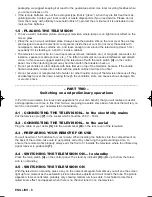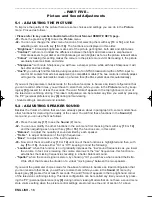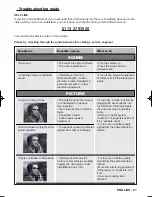
ENGLISH - 6
CONTROL PANEL on the front of the television
NOTES:
• Some models have
a control cover flap.
Press in the middle
to release it.
• Front panel styles
may differ.
[A] Main power switch. Switches the television on and off.
[B] Stand-by indicator. Lights when the television is on stand-by. See 'Remote control key func-
tions' item [12], the stand-by button.
[C] • The OSD button • displays the Programme Change, Brightness, Contrast, Colour and
Sharpness controls in sequence. In stereo# version televisions it also displays the Balance,
Treble and Bass adjustments.
[D] • In the TV mode • it lowers the volume of sound.
• If the OSD button has been pressed • it recalls the programme number below the current
one or decreases the setting on the adjustment bar.
[E] • In the Stand By mode • it turns the television on.
• In the TV mode • it increases the volume of sound.
• If the OSD button has been pressed • it recalls the programme number above the current
one or increases the setting on the adjustment bar.
[F] Receiver of the infrared signals sent from the remote.
[G] Cinch# socket for the input of a Video signal.
[H] Cinch socket L# for the input of a Sound signal.
[I]
Cinch socket R# for the input of a Sound signal, not on all models.
[L] Socket for connecting stereo headphones or earpiece.
SOCKETS AND PLUGS ON THE REAR COVER of the television
[M] Socket for the aerial input.
[N] Scart 1 socket for external equipment.
[O] Scart 2# socket for external equipment.
[P] Mains supply lead and plug.
[Q] Plug of your aerial’s cable.
[
A
]
[
B
] [
C
] [
D
] [
E
] [
F
]
[
G
] [
H
]
[
I
]
[
L
]
[
Q
]
[
M
]
[
O
]
[
N
]
[
P
]
(Other
European Countries)
(Only for UK)
–––––––––––––––––––––––––––––––––––––––––––––––––––––––––––––––––––––––––––––––––––
FEATURES ON THE TELEVISION
Testo del man. SWING (UK) 14-10-2002 9:41 Pagina 6







































